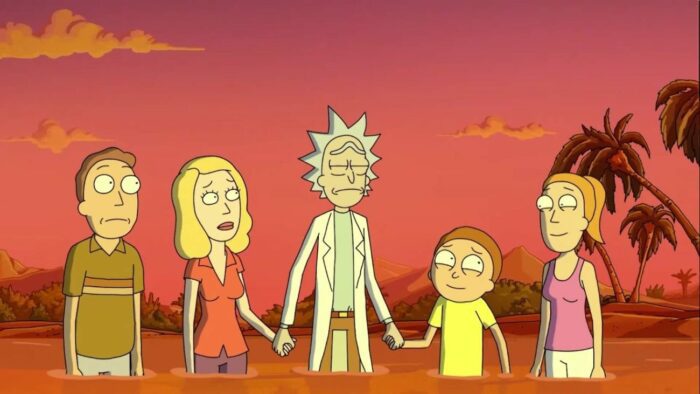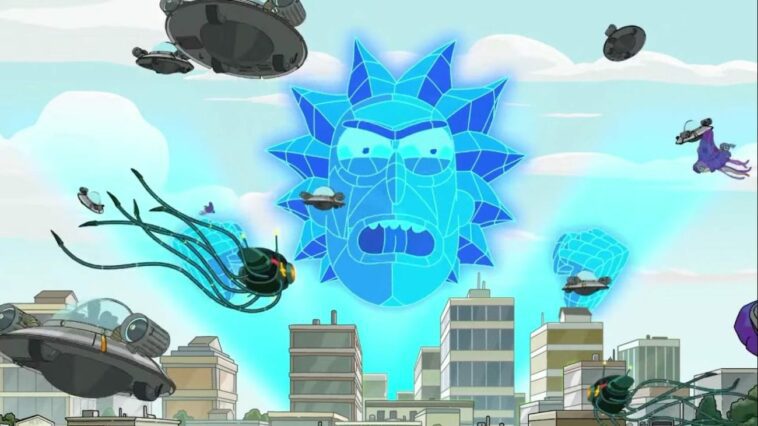In the destabilising second instalment of Rick and Morty Season 5, Rick continues to be haunted by the consequences of cloning Beth, and, among other things, Morty finally gets that cool laser whip he asked for in ‘Promortyus’. S5E2 also includes enough decoys to make for a seriously dangerous drinking game, one visually confusing boss battle, and a post-credit scene that will make you go ‘I need to re-watch ‘Highlander’.

This week the show is on very familiar thematic territory, exploring creation and hubris in the face of Rick’s status as an “unloving god”. It even opens with a bit about the Christian God being real (who is apparently now canon in the Rick and Morty universe). The plot hinges on the reveal that Rick has created several (around 50—perhaps one in every state) ‘decoy’ families across the country to act as a “buffer”—an added layer of protection. This obviously backfires, as the decoys react predictably negatively to discovering that they might not be ‘real’. For Rick, it becomes “one more I-told-you-so about synthetic life or whatever this week’s theme is”.
The apple doesn’t fall far from the tree, and Rick’s decoys have been busy making decoys of their own. Rick calls it an “Asimov Cascade”, referring to the science fiction author Isaac Asimov, whose book I, Robot (which inspired the 2004 film of the same name) outlines the Three Laws of Robotics. The third of these is simply that “a robot must protect its own existence”. ‘Mortyplicity’ sees the chaotic escalation of this principle, as every “robot”, or “decoy”, fiercely defends its belief that it is the one true Rick that must be protected. All the decoys share Rick’s selfish—or to put it more charitably, protective—nature.
The destabilising structure of S5E2—fake-out after fake-out—may leave viewers feeling either uneasy or excited, anxiously anticipating the next twist. Fans should know by now to never get complacent, to always be in doubt…but in a good way. The episode uses the grim shock of Summer cutting her arm (in the decoy-rampage montage) to glance at the psychological immensity of the subject matter as it passes by. Rick and Morty is not the kind of show to linger on such consequences, always instead prioritising fun. The show is implicitly engaging in optimistic nihilism, seeing the bleak world as a colourful adventure playground. This is alluded to when Morty accuses Summer of using the possibility they might not be ‘real’ as “an excuse to stop trying”, and she replies: “yeah, so?”
You think the mere suggestion I’m fake would break me?
– Rick Sanchez
Indeed, there’s nothing like watching (what you think are) the main characters get killed in the cold open to kick off a part-Asimov part-Brecht existential spiral. Since Plato’s Cave, speculative fiction has lost sleep over illusory self-hood, but the unwaveringly egotistical Rick Sanchez seems either unbothered, or (as Beth claims) entirely steeped in denial. However, the wooden decoy Rick, who is leading a resistance, could be construed as looking quite Pinocchio-esque—is this hinting at Rick’s unspoken desire to be a ‘real boy’?

Far enough down the line, there be monsters
– Decoy Rick
When the family is kidnapped after trying to go off-grid, it leads to a scene that is pure horror, including a spin on genetic degradation (like something out of The X-Files episode ‘Home‘) and a decoy Rick who has been flayed. In this sequence, meant to highlight the extreme consequences of the cascade, there is a literal straw-man decoy. This is ironic, since in philosophy, a ‘straw-man’ is an argument or proposition that is parodied into a weaker version of the real thing, thus making it easier to defeat. This is arguably how the decoys—getting weaker with every iteration—represent only an imitation of the god-like ‘real’ Rick Sanchez.
Not only do we not know if the characters are ‘real’ or decoys from one scene to the next, we can’t know for sure yet if the Rick and Morty we will meet next episode will be decoys, since the closing scene left it delightfully ambiguous. The time crystals in last episode’s cold open had seemed to give credence to the theory that not every episode takes place in the same dimension with the same Rick and Morty. Now, the sentient decoys throw another spanner in the works. But the question of who the ‘real’ Rick is may not be worth sweating over, since at the end of the day, none of the Ricks are real, and they will probably continue to be treated by the writers as bendable, expendable fictional devices—because that’s what they are.
Because of how regularly the show employs the distancing effect, Rick and Morty fans may sometimes feel like they are observing the science fiction genre from afar, rather than sitting inside the story. It is somewhat difficult to get immersed in a world that so flippantly pulls the rug out from under the viewer—as is demonstrated to ridiculous proportion in S5E2. This is not a criticism; if anything it’s laudable that even in its fifth season, the show can still surprise people

But what toll does this lack of immersion take on the show’s attempts at emotional development? After all, there is a version of Rick in this episode who apologises to Beth and tells her he loves her, but he is promptly killed off. Having protagonists with laughable life expectancies arguably makes a mockery of the audience’s emotional investment. Can we really expect more than two-dimensions from the animated family? The continued popularity of the show suggests that the answer is ‘yes’. Rick and Morty has more heart than one might expect. What cannot be missed in the carnage of the episode is the great lengths that Rick continues to go to in order to protect his family.
Whether Rick will have learned an emotional lesson from this episode is doubtful. It was good sci-fi fun, and perhaps a hint that there may be some kind of resolution to Rick’s angst over Space Beth, but as always, nothing is guaranteed. Rick and Morty makes a nice contrast to all the talk of a “sacred timeline” in Loki—rare is anything that could be called “sacred” in this universe, and if it exists, it’s never long before someone tries to duplicate it. It’s decoys all the way down.

